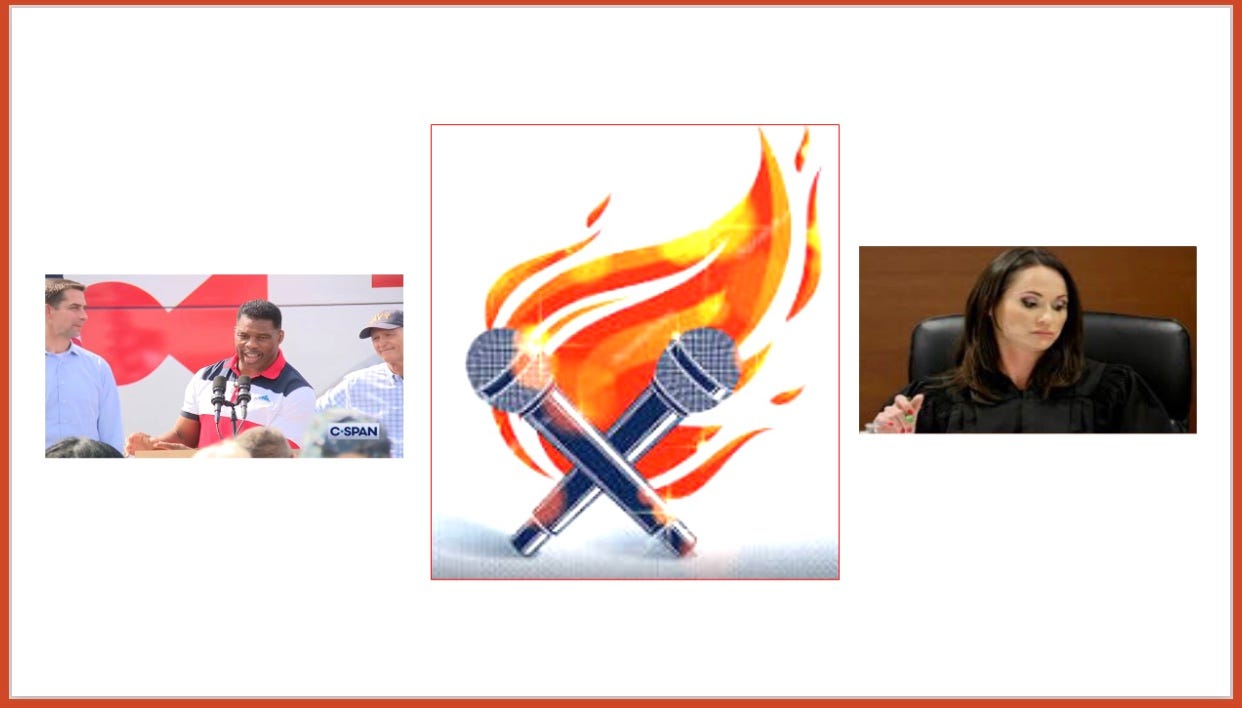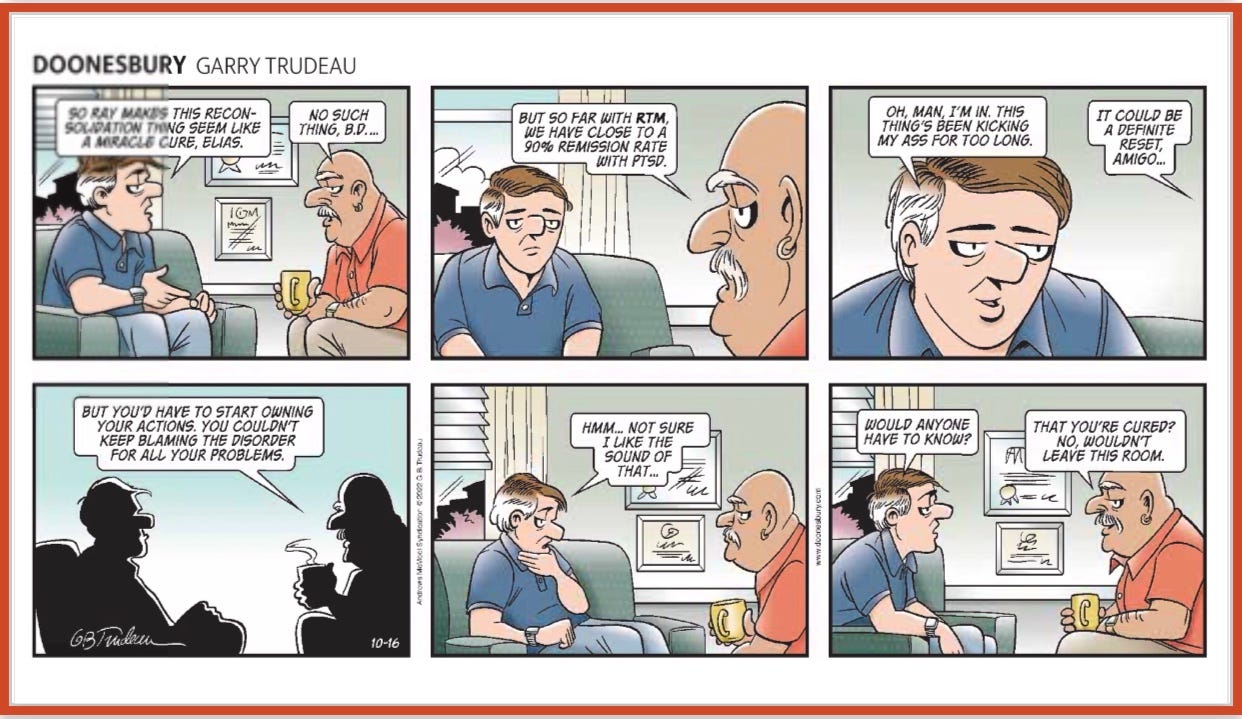Greetings, this news-week with little October surprise. ‘Tis the season of contentious noise, quite literally amplified.

Hence the hot mics title theme and images.
You’ve likely caught some of these moments: Perhaps Pelosi-Schumer on January 6 Insurrection hearing tapes, sound-bites from the many campaign debates, or PA candidate John Fetterman’s national news interview about his continued stroke recovery using closed-caption assists.
The above-pictured pair illustrate vast current extremes of content, procedure… and noise level.
In a nation already long-intensely divided across numerous issues and values, it’s now 16-day countdown to November 8 midterm elections. Early and absentee voting are in progress under states’ widely varying schedules and laws. (Our NC in-person early voting began Thursday and runs through Saturday, November 5.)
The current escalated rancor probably warrants a truism-update to the well-known paraphrase from Shakespeare’s The Tempest: That such societal miseries as politics make strange bedfellows.
This is where the quirky pairs of today’s title came to mind.
In the present acrimonious environment, the most apt description is not so cozily —much less literally! — bedfellows. Today circumstances constantly throw together contending or collaborating dissimilar people and combinations of ideas, events, imaginings and creations that range from merely quirky to most bizarrely disparate opposites.
From a Jungian perspective this is like a festival! The richly diverse trove illustrates the dynamic tension of opposites at the core of his depth psychology of the unconscious (also termed soul or psyche.)
A concept refresher here: At the collective, societal level this essential, creative tension is defining of a democracy. In a healthy society it’s the push-pull tension between individual and society/collective. Within psychologically healthy, awake individuals it’s the constant “outside-in-vs-inside-out,” back-and-forth equilibrium between our societally-adapted conscious ego self and our “inside-out” felt-experience and engagement with the unconscious/soul-Self. This is individuation, the process of becoming ever more awake, authentic and whole across the entire adult life-span.
Minding cues from my recent writer’s-elbow protests, I’m pleased that today’s newShrink turned out to be a comfortable “midsized-essay-vehicle!” First focus is news and clinical psychological perspectives.
🔷
from bullish chaos…
If you haven’t experienced the above-pictured Herschel Walker “randy bull” anecdote delivered in an already chaotic campaign, I recommend viewing it verbatim via You Tube. There’s a good factual Newsweek story on it. And Colbert and other comedians have well-mined its elements both hilarious and unsettlingly ironic.
My having followed a fair amount of coverage in pivotal races, including Walker’s, the bull’s entry in awareness was a Rubicon-point at which all began to sound like noisy gibberish. Unable to take in or process more, I’d begun turning off volume of TV and screen news, sticking to reading and even reducing content-rich radio and podcast fare.
So it was across that silent “post-Herschel bull” TV screen that a breaking-news alert caught my eye. A jury-sentencing decision was imminent in the capital murder case of Nikolas Cruz, convicted shooter in the devastating 2018 Parkland, Florida, school shooting.
Attention piqued, I turned up the volume.
… to eloquent silence
What ensued in Judge Elizabeth Scherer’s courtroom was spellbinding in a way I don’t recall experiencing. The roughly hourlong, uninterrupted live TV news began as several minutes in total, waiting silence. On-camera was only the seated judge.
After Scherer received the jury’s completed forms with their findings on each of 17 counts, the camera caught her long, first-silent reading to check for correct completion of the forms. On the hot mic were only very long minutes, the only sound her quietly rustling papers. (Many mindless tasks I no longer recall got done as I listened.)
In this extraverted, time-is-money culture, how seldom this much silent stillness is ever allowed on live TV, hot mic… (or in everyday life.)
Rather than intensifying the dramatic moment, the controlled stillness instead had a settling-in and safely framing effect visible in the room. It served as preparation for what came next: The methodical reading-aloud of each specific item from the jury findings, on each of 17 counts.
Seventeen times, first came findings of many multiple aggravating circumstances that weighed toward execution, then fewer mitigating ones pointing toward life. The citing of so many more, and egregious, aggravating factors seemed clearly to point to a sentence of death.
Having sat through capital cases as a reporter, by reading of the second jury finding I understood the sentence would be life, not death, despite our hearing the many more aggravating than mitigating circumstances found by the jury. Florida law requires a unanimous jury for a death sentence. Here the requisite more than one (3) jurors had decided against death on each count.
Therapy in real time
For many of the shocked familes and loved ones of Cruz’s victims in and beyond the courtroom, this was a devastating and freshly wounding outcome. Visible on camera in the room, awareness gradually came to faces and bodies. The very slow, methodical, almost hypnotically structured repetitive reading of the findings was providing them in real time a safely containing, holding space. The ritual court procedure itself was allowing them to take in and absorb the difficult factual information, come to slow awareness of the significance of what they were hearing. and begin attending to the emerging intense emotions.
trauma and grief: collective society
From a psychological standpoint that Parkland courtroom struck me as profoundly similar, on the collective level, to the disciplined ritual framing, tightly contained process and space required for healing in effective individual psychotherapy. It is containment for holding the un-holdable until it can be taken in, absorbed, processed. All of which has to happen in order that — through conscious care and intention — it can be ultimately integrated — not eliminated, cured, gotten-past, medicated, buried or stuffed. That, in a nutshell, is healing, health: Wholeness.
Perhaps inevitably from the newShrink perspective, the disciplined rituals of this TV news courtoom got me thinking of its glaring contrast to parallel images we also watched play out on national TV news: the January 6th Capitol insurrection. From that utter chaos, noise, rupture — in the absence of these essential rituals and safely containing structures for our nation’s peaceful transfer of power — in a palpable way, we have been and remain a nation in the post-traumatic stress of terror and unresolved grief.
Aftermath symptoms include: the many continuing denials of both election and insurrection; violently aggressive or self-inflicted acting-outs; re-enactments of the attacks; and rallying plans for various new electoral insurgencies. More hopefully, also in progress are the many ritualized, safely containing methodical institutional processes from House hearings to courts at every level. Tedious and seeemingly never-ending as they are, these can be viewed as perhaps our best hope for a nation more united, eventually.
I think here of Lincoln, the Civil War and its seemingly never-ending aftermaths still playing out today. We have had the intentional healing-ritual processes and remedies of attempted lasting Reconstruction. And we’ve also had the aftermath-rise of the lost cause, Jim Crow, repeated white supremacy and resurgences of Ku Klux Klan and antisemitism.
The well-known flashbacks of trauma and unspeakable loss — the involuntary (unconscious) replaying or angrily/desperately acting-out of unbearable memories — can be understood as attempts by the wounded, alienated, abandoned, rejected parts of us to come home. Such grief has been described as love that has nowhere to go.
Psychologically speaking, these dynamics apply to both collective society and individual person alike.
trauma and grief: individual person
In interesting synchronistic timing, this Doonesbury comic found me last Sunday with the above thoughts from that Parkland courtoom still fresh in mind (and no idea or intention to discuss or write about trauma and grief therapy this week!) The comic highlights excellent RTM — reconsonsolidation of traumatic memory — therapy. Often quite brief, it’s highly effective relief for traumatic suffering triggered by unbearable memories of profound loss, catastrophic events/attacks/injuries, or developmental (childhood/teen) abuse and neglect.

RTM works “from the inside-out” by altering how a specified difficult memory feels — emotionally, physically, unconsciously. This happens through guided revisiting of the memory while being cued sensory stimuli, physical elements like color, smell, eye-movements, hand vibrations and structured visualizations. The shift happens at the unconscious (including cellular/muscular-memory) levels.
As quickly as in a couple of sessions — fastest the more specific the painful memory-recall — contents of the memory are retained (consciously) without discomfort as the painfully triggering emotions attached have (unconsciously) been “reconsolidated” within one’s full emotional range and larger life-narrative.
That’s the clinical Tx.
And from the depth perspective, in archetypal initiation across cultures over time, such reincorporation marks culmination of ordeal — Dante’s Paradiso!
I highly recommend such RTM therapies, have experienced their benefits and can gladly provide referral and resource information to those interested in knowing more.
🔵
Now another of today’s quirky pairs, these from literature and film.
First (pictured at left here) is a bookish footnote follow to recent-edition mentions of my book club’s selection this month, Edith Wharton’s The Age of Innocence. It surfaced in discussion of female recipients of prestigious literary awards and 1870s Gilded Age New York history. (Cycle and Rhyme, 10.9.22, on the website.)
“Get busy living…”
At age 59 an established novelist and interior designer, New York aristocrat Wharton was the first woman to win the Pulitzer Prize for literature with her 1921 novel The Age of Innocence. (I had read other Wharton works decades ago, but somehow missed this one. I haven’t seen the 1994 Martin Scorcese film version, either.)
On the pro side in my view:
🌀Wharton’s grasp of the machinations of a tightly choreographed, closed society, social commentary, wickedly spot-on wit and insight regarding social mores and human dynamics.
🌀In this, though her setting is NYC her pithy hilarious asides and narration echo and sometimes rival certain branches of my, and perhaps many others’, Southern family trees!
🌀 She captures the intense pressures and dominance by the era’s aristocratic society over individuals and relationships, particularly scripted gender roles and marriage, suggesting with its absence a longed-for different ideal.
In my con-column, the novel and its characters are rather vivid antithesis — or perhaps case examples in need of the couch of depth psychology, soul-conscious therapy. Innocence is counterpoint to my long vocation of study, practice, writing on psychological maturity, adult individuation, most of all conscious, soul-level relationship. (Examples in newShrink are many — Ross and Marion Woodman, Mike and and Mickie Krzyzewski, Vladimir and Vera Nabokov, the Greek myth Eros and Psyche, et.al.)
Here the shrink in me craved a fully drawn, psychologically awake character or two — people as evolved and complexly developed as two-continent cosmopolitan Wharton herself.
Wharton’s genius grasp of power and intricacies of societal norms and mores is brilliant. Yet I’m left with a sense of some profoundly sad, perhaps autobiographical, element here. She wrote the 1921 novel at age 59, but set its story and characters 40 years earlier in the 1870s of her own coming-of-age.
From the novel’s penultimate chapter, the some-40-year time-gap leap — from 1870s story to retrospective ending, with main characters dead or in their late 50s — was at first just a precipitous surprise. Then a sad futility of the implicit “nothing happened, nothing to look at here” message hit: Everyone’s long-since nodded back off, to sleepwalk scripted parts until dead or too calcified to chose differently, whichever arrived first! Egad.
Never mind that essential dynamic tension between individual and society, particularly a democratic one, here. By the end of Wharton’s final-chapter finale of fatigued resignation, the hefty weight of societal authority has pretty much vanquished the individual.
First I protested aloud, something like: “Wait, society does press upon, shape and contain our individual lives, actions, sense of self…. AND the individual is supposed to be pushing back! As with writers-and-editors, yin-and-yang??”
At this point, incongruously the tune and a silly paraphrase of an obscure old song kept coming to mind. “I fought the law, and the law won” morphed to “well, she fought society, and society won.”
Apparently still an ending I couldn’t leave alone…
For in my mind’s eye suddenly I wanted to take Wharton’s Newland Archer and company lovingly/firmly by the hands — or collars! — into a different book and film. (Pictured above-right.) I imagine introducing them to Shawshank Redemption’s Andy Dufresne and Red Redding, to complete that headline admonition:
“Get busy living…. or get busy dying.”
Which led naturally to a short-list favorite film-finale that speaks eloquently to the journey of individuation — through Inferno and back as with Dante, through Shawshank sewer, parole and beyond. My 2014 dissertation even cites it:
I find I’m so excited I can barely sit still or hold a thought in my head. I think it’s the excitement only a free man can feel, a free man at the start of a long journey whose conclusion is uncertain.
I hope I can make it across the border.
I hope to see my friend and shake his hand.
I hope the Pacific is as blue as it has been in my dreams.
I hope.
(Film character Red Redding The Shawshank Redemption, 1994.)
🔵
In other seasonal spirit I’ll leave you with a light touch…
Soooo beyond quirky…
First let me stipulate, I find PJ dress-up at school, preschool or the occasional cozy home snow-day a fun treat (and not just for kids.) But for awhile now the grownups have shifted us all toward not-pretty “street-clothes-free living” everywhere from airplanes and city streets to school, church and grocrery store line. Now this:
The event pairs two more quirkily-unmatched things. So many questions! For instance, comfy-coziness — isn’t that by definition kind of private? And the delight of running a race with a crowd — isn’t well-designed, cool-looking running wear and gear a fun energizer? (Let’s don’t even ponder, what if we don’t have or wear pajamas?)
This event blurb brought to mind a joke’s-on-me sheepish moment with granddaughter Miz E during “summer camp” here. I hadn’t noticed arrival of drill sergeant-Tishie over PJs! At the start of the week I was cheerleading how we get up and put different kinds of clothes on here, to do different neat things — and then it feels sooo good to relax back into comfy PJs. At this E looked at me quite seriously, led me by the hand to her packed bag and said in her most helpful voice, “OK, see? I have some PJ’s that look like clothes — maybe I could wear those?”
Humbling. Good for the soul, I’m told.
🔵
(It’s that time, please do…)
And, that is all I have! Talk to you next week.
🦋💙 tish
… it is important that awake people be awake,
or a breaking line may discourage them back to sleep;
the signals we give — yes or no, or maybe —
should be clear: the darkness around us is deep.
— William Stafford, “A Ritual to Read to Each Other”






